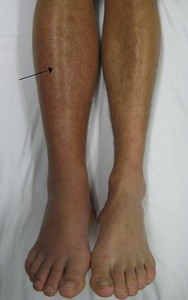Visit and Join the WeHeal DDVT/PE Community.
For more information, see:Mayo Clinic | Wikipedia | CDC

Visit and Join the WeHeal DDVT/PE Community.
For more information, see:Mayo Clinic | Wikipedia | CDC

Deep Vein Thrombosis and Pulmonary Embolism (DVT/PE) are often underdiagnosed and serious, but preventable medical conditions. Stagnant behavior and lack of movement such as sitting in airplanes for prolonged periods of time increase risk.
Deep vein thrombosis (DVT) is a medical condition that occurs when a blood clot forms in a deep vein. These clots usually develop in the lower leg, thigh, or pelvis, but they can also occur in the arm.
It is important to know about DVT because it can happen to anybody and can cause serious illness, disability, and in some cases, death. The good news is that DVT is preventable and treatable if discovered early.
Following is a list of factors that increase the risk of developing DVT:
• Injury to a vein, often caused by Fractures, Severe muscle injury, or Major surgery (particularly involving the abdomen, pelvis, hip, or legs).
• Slow blood flow, often caused by: Confinement to bed (e.g., due to a medical condition or after surgery); limited movement (e.g., a cast on a leg to help heal an injured bone); Sitting for a long time, especially with crossed legs; or Paralysis.
• Increased estrogen, often caused by: Birth control pills Hormone replacement therapy, sometimes used after menopause Pregnancy, for up to 6 weeks after giving birth
• Certain chronic medical illnesses, such as: Heart disease, Lung disease, Cancer and its treatment, Inflammatory bowel disease (Crohn’s disease or ulcerative colitis)
• Other factors that increase the risk of DVT include: Previous DVT or PE, Family history of DVT or PE, Age (risk increases as age increases), Obesity, A catheter located in a central vein, Inherited clotting disorders
The following tips can help prevent DVT:
• Move around as soon as possible after having been confined to bed, such as after surgery, illness, or injury.
• If you’re at risk for DVT, talk to your doctor about: Graduated compression stockings (sometimes called “medical compression stockings”), Medication (anticoagulants) to prevent DVT.
• When sitting for long periods of time, such as when traveling for more than four hours: Get up and walk around every 2 to 3 hours. Exercise your legs while you’re sitting by: Raising and lowering your heels while keeping your toes on the floor. Raising and lowering your toes while keeping your heels on the floor. Tightening and releasing your leg muscles. Wear loose-fitting clothes.
• You can reduce your risk by maintaining a healthy weight, avoiding a sedentary lifestyle, and following your doctor’s recommendations based on your individual risk factors
Visit and Join the WeHeal DDVT/PE Community.
For more information, see:Mayo Clinic | Wikipedia | CDC
WeHeal is very grateful to our valued sources of information which include Wikipedia, WebMD, ClinicalTrials.gov, Cancer.gov, Infoplease, and the US CDC (Center for Disease Control).